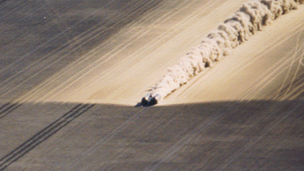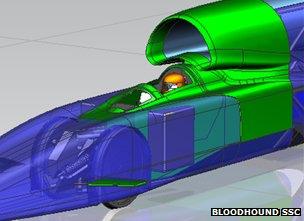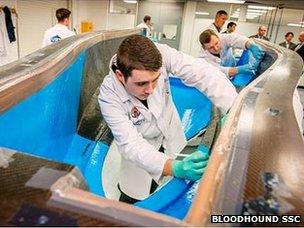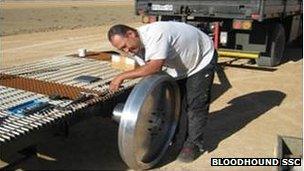Bloodhound diary: Piece by piece
- Published
A British team is developing a car that will be capable of reaching 1,000mph (1,610km/h). Powered by a rocket bolted to a Eurofighter-Typhoon jet engine, the Bloodhound SSC (SuperSonic Car), external vehicle will mount an assault on the land speed record.
Wing Commander Andy Green, world land-speed record holder, is writing a diary for the BBC News website about his experiences working on the Bloodhound project and the team's efforts to inspire national interest in science and engineering.
Happy New Year - I hope your New Year has started off as well as ours has.

Thrust SSC – Supersonic and from Sussex
One of the great things about working on Bloodhound is that we all share in the "Engineering Adventure".
Our long-term aim is to inspire a generation of young people about the magic of science and technology through the Bloodhound Education Programme, external (sign up your school here, external if you haven't already - it's free). In the meantime, while they are learning about Bloodhound technology, I get to learn a huge amount about it as well - and it's fascinating.
I've just been down to visit URT, external composites on the Sussex coast, to see a major piece of the car in manufacture.
This small area of Sussex has an amazing link with speed: the world's fastest car, Thrust SSC, was created here in the 1990s, and the body of the fastest-ever diesel car, the JCB Dieselmax, was built here, too. Now we're back here again for a world-class product that will do 1,000mph. Great Britain really does have wonderful engineering expertise in some unlikely places.
URT is currently racing through the build of our carbon fibre monocoque - the major chassis section from the front wheels to the middle of the car. The word monocoque literally means "single shell", and is a thick load-bearing skin that forms both outer surface and chassis in one.

The "single shell" chassis
The monocoque has to carry the cockpit (and me!), the rocket oxidiser tank containing one tonne of hydrogen peroxide, the front suspension and steering sub-assembly, and the jet engine intake. It's a busy piece of the car.
It also has to provide the strength in the centre of our six-tonne vehicle (7.5 tonnes with fuel) and withstand some pretty extreme forces: aerodynamic loads of up to 12 tonnes per square metre, and acceleration and deceleration loads of up to 3g (three times the force of gravity).
To picture 3g, imagine driving at 60mph - and then stopping dead in one second. That's a 3g deceleration. You'll rapidly realise that the only way to achieve this is to crash into something (don't try this at home) - and Bloodhound is going to be subjected to this much load on every high-speed run.
Our suspension consists of independent double wishbones - in other words, each wheel has its own suspension, which consists of two horizontal V-shaped brackets, one above the other, hinged on the side of the car.

Big Loads, big bearings
This sophisticated suspension will ensure precise control of the car on the desert: the surface is very smooth, but no surface is perfectly flat and there is no such thing as a small bump at 1,000mph. The wishbones (the V-brackets) move up and down on bearings. A normal race car bearing is about the size of a marble, while Bloodhound's is closer to the size of an apple. Big loads, big bearings.
So how does URT make a carbon-fibre monocoque to a precise shape and to take this load?
They first produce a "buck" (a solid copy of the final shape), precision-machined from a solid block. They make a mould from this in carbon fibre. The mould is made in two halves, upper and lower, so that they can get inside it to make the final parts. The monocoque is about 20mm thick, with a thick carbon outer skin, a foam core and a inner-carbon skin.

URT experts hard at work
The carbon skins are made from multiple layers of carbon fibre sheets impregnated with resin (seven layers for the outer skin, five layers for the inner). Each piece of sheet is pre-cut and then laid up in a precise position, with the strands of woven carbon running in different directions for each layer, to give a precise amount of strength in each direction - clever stuff.
When I got there, the outer skin had already been laid up and "cooked" in an autoclave (a very large oven) at up to 10 Bar (150 psi) and 135C. They were kind enough to let the new boy have a go, so I got to add a layer of carbon fibre to the inner skin of the monocoque. A big thank you to Josh Cox at URT for his help and patience while I made it look difficult!
Once all five layers of inner skin have been added, the upper and lower moulds will be joined for the first time. Then the whole thing goes back into the autoclave for another cure, before final machining - and we should get the finished product in a couple of months or so. Can't wait to see it.

The "new boy" under supervision
While the final cockpit and monocoque is being made in carbon fibre, we've used the fibreglass "splash" to develop the cockpit mock-up. While the 3D computer design is very detailed, I still need to sit in the cockpit (or in this case an exact copy) to confirm the exact position of the seat, steering wheel, pedals, etc.
We can then fix the exact position of the instrument panels to the rest of the controls in the cockpit. By the time the final carbon-fibre piece arrives from URT, we should be able to pull the internal fittings out of the mock-up and fix them straight into the cockpit, saving us a lot of time later on. I have to admit that each time I get into the cockpit mock-up and imagine the finished version, I get quite a thrill. This is going to be a remarkable vehicle.
While the chassis is being manufactured, we're still working on some fine detail. This includes the aerodynamic stability - making sure that the fin is big enough to keep the car pointy-end forwards. To do that, we need the aerodynamic centre of the car to be behind the centre of gravity.

Getting ahead on the cockpit details
As the various bits of car are being manufactured, we are continually updating our calculated centre of gravity, so we need to keep checking the stability.
At the moment, it's not quite stable enough at slow speed (below 600mph). We have a positive "yaw static margin" (the distance between the centre of gravity and the aerodynamic centre) while the car is accelerating, but the car's centre of gravity moves back slightly as we burn off the fuel, and this leaves the car less stable as it is slowing down. A small increase in the fin size (perhaps 50mm at the back edge) should make a big difference - and will also give room for a few more names! Have you put your name on the fin yet?, external
After the recent wheel test in South Africa, external, Ron Ayers, our chief aerodynamicist, has been analysing the results.
Based on the data that he collected, we can make the V-shaped keels much shallower, or even remove the V-keel altogether and use a rounded profile. This will reduce the depth of the wheel track and reduce the risk of damaging the wheel surface on buried stones. We've got about two months to make the final decision, as the forging of the wheels is being done in March, before the final machining in May.
Something as apparently simple as making the wheels shows just how many companies are involved in a world-class engineering project like Bloodhound. The lead contractor for the wheel programme is Castle Precision Engineering, external in Glasgow, with design and analysis support from Innoval Technology, external and Lockheed Martin (UK), external. Plate aluminium is being supplied by Metal Web, external, while raw liquid aluminium (for the forgings) comes from Trimet, external.

Wheel testing in South Africa
Otto Fuchs, external will carry out the forging, after which the wheels are shot peened. Wikipedia defines shot-peening as "a cold working process used to produce a compressive residual stress layer and modify mechanical properties of metals".
What that means in English is blasting the surface with thousands of tiny lumps of "shot" to relieve surface stresses. There's a lot of stress in a 1,000mph wheel, so anything we can relieve in advance is good. MIC, external will complete the shot-peening, before Amfin, external carries out non-destructive testing and finally WDB, external will balance the wheels.
There's a lot to do just to make the wheels, never mind building the rest of the car to sit on them - 2013 is going to be quite a year - I can't wait!
- Published2 January 2013
- Published30 November 2012
- Published3 October 2012
- Published2 October 2012
- Published23 September 2012
- Published12 September 2012
- Published24 August 2012
- Published7 February 2011
- Published21 November 2010
- Published13 November 2010